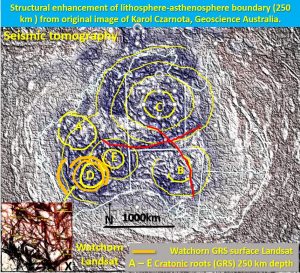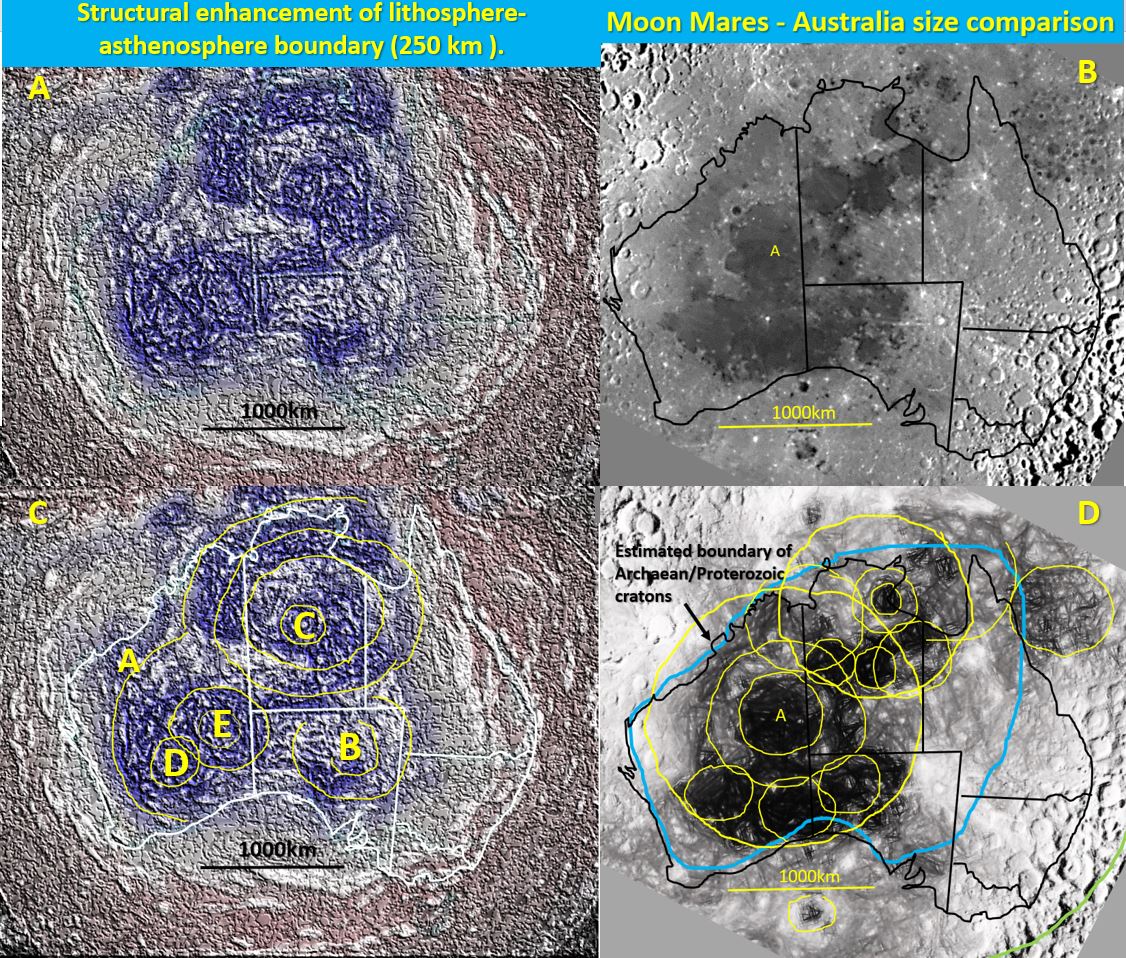Moon Mares and the Australian Lithosphere-Asthenosphere 250 km deep boundary comparison using seismic tomography (Paper 1).

This paper is the first to summarise my recent research on Moon mares and their comparison with giant ring structures (GRS), also called phi (Ø) structures, in Australia with reference to their seismic tomographic footprint at 250 km depth.
There has been little published structural research or images on the comparison of the structural geology of Lunar mares and Archaean cratons. The earliest, now buried, Hadean eon geology of the earth has not been published widely. The visible moon mares were formed during and after the Late Heavy Bombardment (LHB) that engulfed the inner solar system from 4.1 – 3.8 Ga with more minor impacts through to 2.6 Ga when Jupiter and Saturn swapped orbits. Earth would have been affected to an even greater extent than the Moon because of its greater gravity hotter core and more plastic mantle.
The near-side Moon Mares basalt lava extrusions cover an area the size of Australia and have a similar shape and area to the underlying Australian Archaean/Proterozoic geology. It is suggested that the LHB formed the original Australian (and world) Archaean Cratons. Their time frame of ~ 4.1 – 3.7 Ga is similar to the geochronology of the moon mares and the oldest rocks at the earth’s surface.
Why use seismic tomography? The seismic tomography researched in this paper shows the structural roots of the cratons under Australia at 250 km depth. A seismic tomography image is obtained by recording in 3D the seismic events on hundreds of seismic recording stations on the Australasian plate. Seismic tomography records the finer structures, as well as the broader ones shown on the image, in a similar manner to a medical tomographic scan.
The deep cratonic roots seen in this image appear to blend and cross the varying surface geochronologies seen in surface geology. This corroborates with the results of ongoing research on giant ring (GRS) or phi structures (Ø) that have been published on geotreks.com.au. The Yilgarn giant ring structures cross the boundaries between the Archaean, Proterozoic and Quaternary to the east and north of the Yilgarn. The density of the observed GRS in the Yilgarn approximates that seen in the moon mares.
The cluster of deep blue areas of the Lithosphere-Asthenosphere boundary correlate with the moon mares visible from earth – at the same scale. It is suggested that they have the same cause.
The Hadean eon of the Earth predates the Archaean. It began with the formation of the Earth about 4.6 Ga and ended approximately with the age of the oldest surface rocks at ~ 4 Ga. In many other areas, xenocrysts of Hadean zircons enclosed in older rocks indicate that the younger rocks have formed on older terranes and have incorporated some of the older material.
Why would this Hadean crust still exist beneath the oldest surface rocks? Some scientists claim that true Plate Tectonics didn’t commence until the NeoProterozoic (1.1 Ga) but others argue that there is ample evidence that the Earth underwent a transition to more global plate tectonics as early as 3 – 2.7 Ga. Either way plate tectonics probably only commenced on a large-scale after 2.7 Ga which is probably 1 Ga after the formation of the GRS in the Yilgarn and is indeed post Archaean craton formation. Thus, the cratons existed for possibly 1 Ga before plate tectonics, which could destroy them, started.
Why didn’t these early cratons sink and be resumed by the core? During this 1 Ga period there was continued large-scale volcanism piling mafic material over the craton areas pushing the increasingly felsic rich (lighter) roots deeper. It is suggested that most of the largest original 4.1 – 3.8 Ga LHB impact created cratons still exist because of this great buoyancy. Their buoyancy would only increase over time as erosion strips off the surficial, heavier mafic lavas.
Why don’t shock structures outcrop on the current Archaean surface? Seismic and seismic tomography sections suggest these Hadean giant ring structures are deeply buried and therefore cannot be proved to be impacts by the restrictive criteria currently allowed for Earth impacts. Currently ring structures can only be proved as impacts by finding shock affect criteria at the Earth’s surface. However, if they are older than ~3.8 Ga they will not outcrop as they were all buried in the LHB and its subsequent enormous outpouring of lavas.
If the surface of the Mares on the Moon were examined the mares could not be proved to be formed by impacts (under these shock criteria) as it is certain that the impact structures that formed them are buried. Extensive use of structurally interpreted seismic data is critical to the correct classification of these structures on Earth.
Can the remains of the original Hadean cratons be re-assembled? Giant arcs, with a calculated diameter of >3000 km, traverse the Australian plate and are observed in the interpreted seismic tomographic data at 250km depth. It is suggested that they are most likely representative (on Earth) of the largest craters that formed moon mares which have similar sized craters. It would be interesting to see if these arcs are continued across the other Archaean/Proterozoic cratons. This may be a method by which they can be stitched back together into the original Hadean supercratons. These supercratons would probably be the same 5000 km diameter size as those on Venus.
Why did the Hadean cratons form deep roots so quickly? The second law of thermodynamics (conservation of energy – refrigeration cycle) states that if pressurized matter (gas to liquid to solid) suffers loss of pressure and reverts to a lower state of matter (solid rock back to liquid lava to gas), then the remaining rock (at depth) becomes refrigerated by comparison to the surrounding rock. This is the cold spray can principle. The great shock (work) of the impact causes pressurization and the subsequent rebound/uplift causes melting and vaporisation of solid rock. This repeated impact refrigeration cycle during the LHB would have cooled the Archaean impact sites which hardened quickly and cratons would have been preserved with many of the original impact structures intact. This refrigeration law is counter-intuitive, is not generally recognised in geology and thus has not been published as the main means of Hadean craton formation and preservation. Thus, scientists should be looking for diagnostic impact morphology and structural features in plan and in seismic and seismic tomography sections. If found then it is reasonably certain that one is looking at an impact structure.
The well illustrated research paper can be accessed below. If you find it useful and interesting share it with your colleagues.
| aaa Moon mares Australasian cratons comparison Section 1.pdf | 1 MB |

